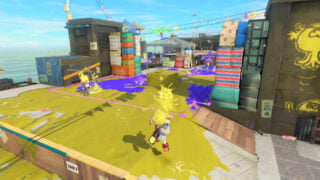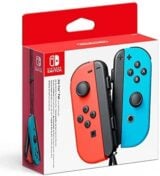Review: Splatoon 3 gives Nintendo’s weirdest world its safest sequel
How do you expect to defeat aquatic enemies without an obvious hook?
- Director
- Shintaro Sato
- Key Credits
- Seita Inoue (Director), Hisashi Nogami (Producer)

There is nothing quite like a down to the wire Turf War clash in Splatoon, and much of the magic dwells in the results screen.
After three minutes of fevered ink-splatting, an overhead map reveals the spread of the two team’s colours. Sometimes a clear victory is obvious: a sea of green bullying a pathetic blip of pink into a corner, say. But it’s rarely clear cut.
Outside of two bases smeared in home colours (unless one team’s done *horribly*) there are streaks, swirls and splatters. It could go either way.
Your brain does a broad calculation while the Switch computes it to a precise percentage point. That tiny window of will it/won’t it is as tense a moment as Nintendo has ever cooked up.
Yes, total annihilation can be fun. And Splatoon 3’s aggressive new specials – spanning crab tanks, kamikaze sharks and boost-dispensing mini fridges – allow organised teams to apply pressure better than ever before. (Side note: don’t buy into the cheerful kindness of Nintendo Treehouse staff on their regular streams – they were merciless death squads in our online tests.)
Splatoon 3 guides:
Splatoon 3 Splatfest | Splatoon 3 tier list
But the best drama is in the 49.9/50.1 colour split nail-biters, where the ebb and flow of your inked domain is felt every step of the way and the tiniest speck of territory makes all the difference. Sometimes the slightest change is enough.
Which seems to be the wider philosophy of Splatoon 3, a sequel that is surprisingly straight by Nintendo standards. Some detractors would say this is the way of things, that the company too often returns to the well of tired favourites. But even in the Mario sports games there’s always a hook to hang a new iteration on.
It’s golf, but also a sprint! It’s karting, but on the ceiling! It’s football, but with stat tweaking! This is Splatoon, but… the online lobby is a physical room you hang out in? Sure, it’s a nice lobby – colouring in the test range is pleasingly zen after yet another Treehouse drubbing – but it’s not the big ‘sell’ you expect from a returning favourite.
No, instead of adding one big thing, Splatoon 3 applies spit and polish to everything. Mercifully, this includes fixes for long-standing quirks: you can now play the Salmon Run horde mode 24 hours a day, instead of in fussy, scheduled windows.
And when maps rotate every few hours, you no longer have to sit through a video broadcast, but can read the info relayed in text. No shade on the new TV news crew, Deep Cut, but there is only so much aquatic wordplay you can endure in a day.
“Instead of adding one big thing, Splatoon 3 applies spit and polish to everything.”
For those keener on the catwalk than the dog-eat-dog battling, there’s more nuance in character creation and many more ways to express yourself. Customisable nameplates and lockers add a mountain of trinkets to pursue – we particularly like the lobby gacha machine that spits out silly nicknames to add to your profile.
It’s a one-two punch: more individuality and more reason to grind for currency. Especially with the new catalogue of timed, seasonal items. It’s basically an in-game battle pass, but one that, crucially, levels up across online and Salmon Run, making the whole game that little bit more cohesive than before.
Speaking of Salmon Run, the fantastically creepy horde mode ruled over by a perpetually unimpressed bear now lets you lob the precious eggs collected from slain boss creatures, setting up relay teams to pass treasures from distant corners of the map all the way up to the main basket.
Countering this ease of transportation are even wilder enemy variations, such as the fish sticks that leave handy sniping towers jutting from the map and a hulking boss that has to be peppered with eggs if you stand any chance of eating his health bar in the limited time limit.
Admittedly, these new treats are flanked by heaps of familiar gimmicks, but it’s still a brilliantly barmy – and by Nintendo standards, brutally difficult – way to enjoy Splatoon’s core combat.
Jettisoning fellow players completely, the story mode is another set of short obstacle courses built to teach you weapon classes, special powers or platforming mechanics. It’s more substantial than the previous campaigns, closer to Splatoon 2’s Octo Expansion in size and imagination, if not difficulty.
Like that DLC, it’s a comprehensive tour of everything you can do in Splatoon 3. Fight a mech in a crab tank! Paint a giant statue! Finish a level with one ink tank! Finish a giant join-the-dot picture! But it’s all so syphoned into bitty stages that no idea can truly take flight.
And it’s not for a lack of depth. Splatoon 3 easily has the weapons and moves to support a complex action campaign. Just the new zipcaster alone – an elasticated take on Link’s hookshot – deserves its own game. The few levels where you ping from pillar to pillar, shattering and splattering as you go, are more fun than we had with the whole 3D reboot of Bionic Commando.
Why keep such a joyful toy limited to a handful of levels and the few seconds you get to deploy it during a match? There’s nothing outwardly bad here – in fact, it eventually reaches a sublime crescendo you have to see to believe – but the whiff of untapped potential persists.
“There’s nothing outwardly bad here – in fact, it eventually reaches a sublime crescendo you have to see to believe – but the whiff of untapped potential persists.”
While we’d never recommend Splatoon 3 to the online-averse, solo squids can also enjoy Tableturf Battles. This card game sees rivals drawing a deck of block shapes and simultaneously placing them on a grid, in attempt to claim as many squares as possible.
Knitting shapes together so not to waste squares taps into your Tetris knowhow, but there’s more at play here, with special attacks, cards battling to occupy the same space and a race to wall in high-scoring squares.
There are so many avenues to victory that your mind is quickly buzzing with strategies, especially once you start building out your deck with new card drops. It could easily blossom into a Gwent-sized side hustle.
As for online battling? It’s great, in the way that Splatoon always has been. Putting the emphasis on colouring maps – at least in the signature Turf War mode – is still a refreshing alternative to the fastest trigger finger first approach of 99% of online shooters.
And the flexibility of that ink, the way your colour both scores you points and gives you a movement advantage, is so purely playful that it’s hard to imagine how it could be radically altered without jeopardising the soul of Splatoon.
The biggest tweak comes in the new triple-colour Turf War variant, a fantastic phase of the revamped Splatfest (where the community fights in the name of one of three sides). It’s a more objective-driven version of the traditional Turf War, with the current Splatfest leaders keeping the two trailing teams away from a signal that summons support ink into the arena.
Splatoon really bursts to life when there’s that extra direction to a fight – focusing your subs and specials, rewarding defence and careful spawning jumps – and this middleground between regular turf war and the deeper objective-driven modes of ranked play feels like a great gateway drug to the latter. It’s almost a shame to limit something this good to a monthly event.
As you can probably tell, it’s easy to slip into a checklist of tweaks when talking about Splatoon 3 – there just isn’t a neat throughline to help pitch the game. As a result, it’s hard to see what might make converts of those who bounced off earlier entries.
Its back-of-the-box features read more like (generous) patch notes than a bold invitation to a world of ink-flinging revolution. But if it provides solid fun within those baby steps, does it truly matter? In a game where point one of a percent can result in its biggest thrills, a major splash of paint isn’t always required.
While it’s weird to see Nintendo deliver such a safe sequel, there’s no denying the continued pull of Splatoon’s splotchy skirmishes. Seasoned inklings can dive straight in; casual dabblers might find it a bit bare.
- There’s still no other shooter series quite like it
- Great quality of life improvements across the board
- Tableturf Battles could become a major timesink
- Story mode is still too stop-start to win us over
- Nothing here to convert the non-believers



























